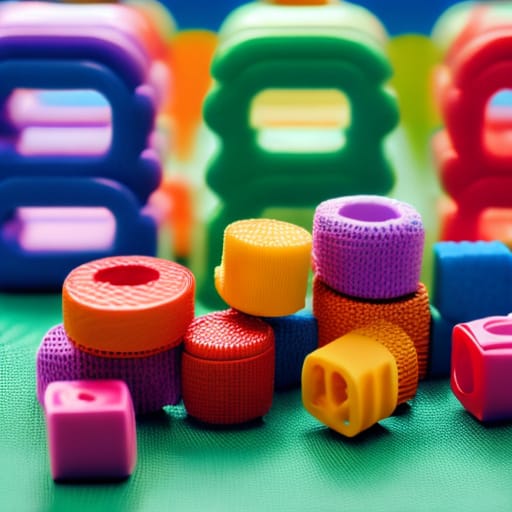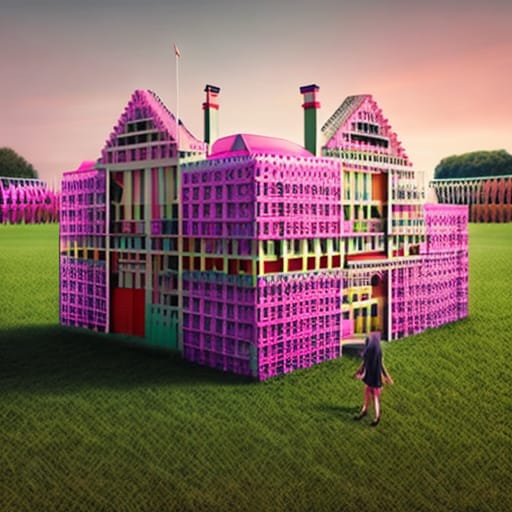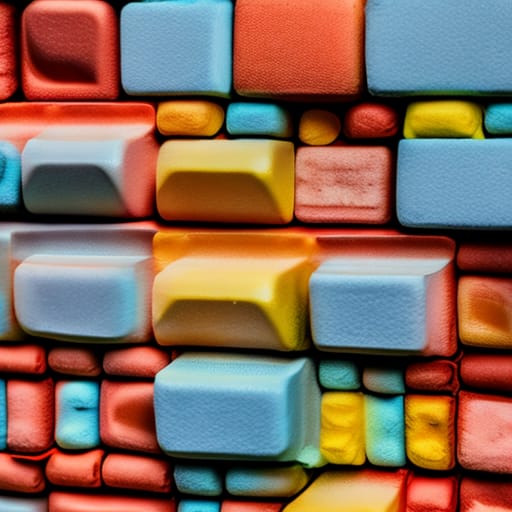Foam brick blocks are a fun and innovative building toy that provide endless opportunities for creativity and learning. As a lightweight and durable construction material made specifically for kids, these blocks open the doors to roleplay, sensory exploration, motor skills development and so much more.
In this beginner’s guide, we will explore everything you need to know about foam brick blocks, from key manufacturers and popular sets to creative ideas for block play and even DIY foam brick projects you can make at home. Whether you’re a parent, teacher or simply a big kid at heart, let’s unlock the world of building possibilities with foam bricks!
What Are Foam Brick Blocks?
Foam brick blocks are, as the name suggests, building blocks made of foam that resemble bricks. They are larger-sized blocks, usually measuring around 5 x 2.5 x 1.25 inches per block. The most common foam brick sets contain blocks in red, green, blue, yellow, orange and other bright colors.
These oversized building blocks are made of lightweight, durable foam materials like EVA or polyethylene. Their foam construction makes them soft, easy for little hands to grip and assemble, and safe for kids as young as 12 months. Foam bricks won’t chip or crack like their wooden counterparts if stepped on or dropped.
Most foam brick manufacturers design their blocks to interlock for stability when stacking vertically. Sets may include specialty bricks with carved patterns, arches, and other detailing to spark creativity. While they resemble masonry bricks, their soft texture and colors give them a lively, toy-like quality perfect for indoor and outdoor play structures.
Key Benefits of Foam Brick Blocks
Foam bricks offer many developmental benefits that make them a top pick for toddlers, preschoolers and young elementary students. Let’s explore why educators, therapists and parents worldwide are turning to oversized building bricks as an early learning tool.
Promote Creativity and Imaginative Play
With no instructions or boundaries, foam bricks let kids construct anything they can imagine. Assembling castles, bridges, roadways, buildings and more sparks open-ended play to develop flexible thinking. Themed playsets containing bricks, figurines, road signs and decorations further storytelling.
Develop Fine Motor Skills
Grasping, lifting, rotating and precisely placing foam bricks hones fine motor control and dexterity. Building play strengthens hands and fingers for later pencil grip mastery. Stacking also improves eye-hand coordination and spatial awareness.
Teach Early Math Concepts
As kids match brick colors, count courses and balance uneven structures, they intuitively learn early geometry, patterning, measurement and problem-solving skills. Comparing brick sizes introduces concepts like large vs small, thick vs thin, and tall vs short.
Enhance Language and Vocabulary
Describing their foam brick creations gives kids practice using positional words like under, above, behind or next to. New architectural terms like tunnel, enclosure or archway enter their vocabulary. Storytelling woven into constructions also expands language abilities.
Develop Cooperation and Sharing
Playing alongside siblings or classmates with shared foam brick sets encourages cooperation, sharing resources and teamwork. Kids learn to take turns, build upon each other’s work harmoniously and communicate ideas respectfully.

Types of Foam Brick Sets
Foam brick manufacturers offer sets tailored to different ages, developmental levels and interests. Parents can find small starter sets for toddlers all the way up to giant bags of bricks for school-aged kids to build infinitely. Here are some of the most common foam brick set varieties:
Basic Brick Sets
These starter sets contain 50-100 colorful basic bricks without advanced shapes or patterns. Usually geared towards 12-36 month olds, basic bricks allow little builders to grasp early construction concepts.
Interlocking Patterned Sets
These mid-sized sets have specially molded bricks like window or door frames, ramps, road signs and architectural decoration pieces. Interlocking components take builds to the next level while inspiring role play scenes.
Giant Value Sets
Family-sized brick bags contain 500+ assorted foam bricks to build bigger structures like playhouses. With endless possibilities, these giants sets work for daycares, classrooms and homeschools seeking an open-ended group building activity.
Themed Building Kits
Some manufacturers offer themed kits containing not only bricks but play mats, background scenes, figurines and accessories to enact narratives from cityscapes to farms, castles and more. These prompt storytelling and role play.
DIY Foam Brick Molds
For a customizable building experience, purchase silicone molds to cast your own DIY foam bricks out of craft materials like liquid foam, melted crayons or soap. Create single piece molds or brick & mortar kits.
Top Foam Brick Brands
With foam bricks rising in popularity for early education and motor development, more toy brands now offer their own unique sets catered to various ages. Here are some of the top manufacturers known for quality and innovation in foam building bricks:
Edushape
Edushape makes the MAGICFOAM Builders line renowned in the early learning community for unique brick molds that spark creativity. They also offer themed kits with storytelling elements to inspire imaginative play.
KidKraft
This leader in kids’ furniture and toys creates the Giant Jumbo and Jumbo XXL Foam Blox lines with extras like windows, arches, ramps and road signs for advanced building. Their sets suit ages 18 months and up.
Hape
Specializing in eco-friendly wooden toys, Hape launched Plantopoly Imaginary Play Foam Blocks made of plant-based polyethylene that looks and feels like wood. Their botanical-themed and architectural shape assortment stands out.
Feber
This Europe-based brand offers the My First Foam Blocks line made of soft, flexible and washable EVA foam in bright neon shades. They sell basic starter sets up to giant bags of 400+ bricks suitable for groups.
Melissa & Doug
Known for innovative toys and games, Melissa & Doug introduced Jumbo Foam Building Blocks with chunky proportions and finger grips perfect for small hands. Textured sides detail the blocks like real stone bricks.
Fun Foam Brick Activities and Games
Aside from freeform building, foam bricks present many opportunities to introduce games, activities and challenges to school-aged kids. Here are some engaging ideas to spark friendly competition:
Building Speed Contests
Teachers can divide students into teams and task them to build a structure as fast as possible before it collapses. Kids develop strategic thinking with fun peer challenges.
Creation Storytelling
Have students build unique structures then take turns pitching stories that might happen inside. Prompt them to name buildings, describe imaginary people and events unfolding inside to boost narrative skills.
Shape Recognition Games
Call out a brick shape, size or color and have kids race to collect matching blocks from a pile. Increase difficulty by calling multiple attributes at once.
Math Estimation Challenges
Before building, ask kids to estimate the height a tower might reach with a certain number of bricks. Test their spatial reasoning by seeing whose guess came closest after construction.
Sensory Foam Play
For younger toddlers, open sensory exploration by playing with just a few bricks at a time. Let them examine textures, grip bricks with feet or hands, transfer between containers, knock down and rebuild.

DIY Foam Brick Ideas and Hacks
Aside from brick playsets you can buy, there are many creative ways families and classrooms can make DIY foam bricks on a budget using supplies like:
- Foam floor tiles
- Foam packing sheets
- Foam insulation scraps
- Foam balls, cubes or blocks
- Paint and marker
- Hot glue
- Craft knife
- Upcycled cardboard
Here are some fun DIY foam brick project ideas to personalize the building experience:
Make Interlocking Bricks
Cut cube shapes from foam tiles or dense sheets and use hot glue to attach decorative bits of foam or cardboard road signs, windows and accents.
Fashion Themed Foam Bricks
Paint plain foam blocks to create themed bricks in various patterns. Make earthy terra cotta bricks, graffiti city buildings or underwater themes with wiggly “seaweed” bits.
Mold Soap Foam Bricks
Melt kids’ soap with water then pour into silicone brick molds. Flexible bricks let kids construct bubble bath towers that fizz away in the tub!
Upcycle for Chunky Bricks
Cut pool noodles, large pieces of thick cardboard or felt into brick sizes. Wrap strips of colored duct tape around to decorate. Sturdy and lightweight!
Key Takeaways
- Foam brick blocks offer open-ended building play to spark imagination and learning in young kids.
- Colorful foam bricks are soft, lightweight and interlock for creative structures that can be displayed or played with time and again.
- Special molds like windows, doors and archways take builds to the next level while introducing new vocabulary and concepts.
- Sets range from starter sizes for toddlers up to giant classroom-sized bags for groups and endless building possibilities.
- Aside from building freeform creations, foam bricks present opportunities for games, contests, storytelling and sensory play.
Frequently Asked Questions
What ages are foam brick blocks suitable for?
Foam blocks are recommended for kids as young as 12 months up to age 10. Basic starter sets with large bricks work well for toddlers from 12-36 months. Interlocking sets add challenge for preschoolers ages 3-5, while giant brick bags allow older elementary school kids to build infinitely.
How do foam bricks compare to wooden blocks?
Foam building blocks are much lightweight yet durable for little hands compared to wood. They’re less prone to cracking or splintering when dropped. Foam construction also makes them soft and safe for infants beginning to teethe. The textured brick patterns remain visible even after heavy use.
What makes foam bricks educational for young kids?
As an open-ended construction toy, foam blocks build key skills from eye-hand coordination to spatial reasoning, shape recognition and even vocabulary. Different sized and shaped bricks also introduce early math concepts. Freeform building sparks creativity, problem solving and motor control in a fun, engaging way.
Can foam bricks be used outdoors?
Yes, outdoor use is one of the advantages of foam bricks compared to other building media. The durable plastics withstand sun exposure and temperature changes. As long as proper drainage exists underneath, foam brick structures hold up to rain. Easy to rinse clean, they’re ideal for sandboxes, gardens and outdoor classrooms.
Are there different foam brick qualities to consider?
Cheaper foam bricks may use lower density EVA foam that compresses easily, causing instability in towering builds. Opt for medium to high density LDPE or HDPE plastic foam bricks from reputable brands for more rigidity. Softer low-density EVA is best for infants; HDPE suits giant constructions.
Can you make DIY foam bricks more affordably?
Yes! With simple materials like foam tiles, sheets or blocks purchased from dollar stores, you can fashion DIY bricks in any size. Hot glue decorative bits for windows and textures, or paint bricks in vivid colors for a customized set. For more durable indoor/outdoor bricks, use 2-part liquid foam casting kits.
